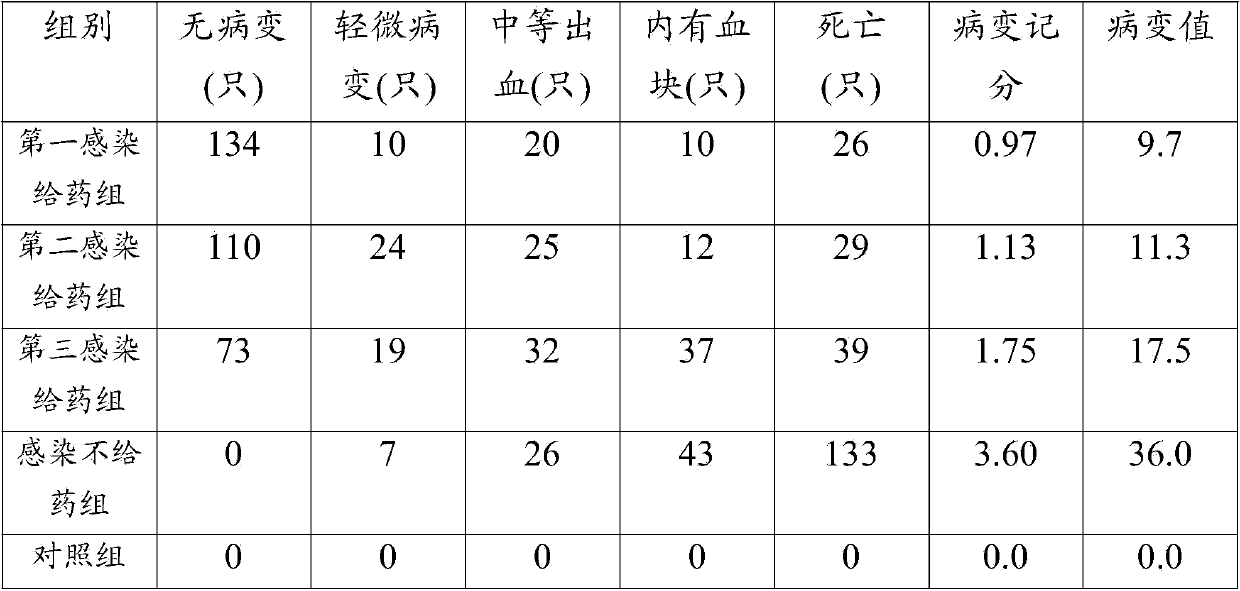Drug for treating chicken Eimeria tenella
An Eimeria coccidiosis and tender technology, applied in the field of traditional Chinese veterinary medicine, can solve problems such as failure of coccidiosis control, reduced feed rate, slow weight gain, etc., so as to improve the body's disease resistance, promote body growth, Less toxic and side effects
- Summary
- Abstract
- Description
- Claims
- Application Information
AI Technical Summary
Problems solved by technology
Method used
Image
Examples
preparation example Construction
[0041] The present invention also provides a preparation method for the above-mentioned feed, which includes:
[0042] The first step is to prepare traditional Chinese medicine powder feed additive according to the above method;
[0043] In the second step, all the raw materials of the above-mentioned feeds are combined in proportion, put into a compound mixer and stirred for 150 minutes, taken out, put into a ring mode grinder, and pulverized into powder, then taken out and put into a dryer, and controlled The dryness of the dried material is 70% to 80%, and the baking time is 50 to 70 minutes. Take it out and let it cool, put it in a compound mixer and stir for 190 minutes, take it out and put it in a ring mode puffing machine for puffing, and control the temperature The temperature is between 70°C and 80°C, the expansion time is 1 to 2 hours, and the dryness of the expanded material is controlled at 80% to 90%. After taking it out, it is transferred to a ring mode hard pell...
Embodiment 1
[0072] Example 1 Decoction 1
[0073] Put 40g Changshan, 75g rhubarb, 25g Caulis Spatholobus, 30g Rhizoma Polygonatum, 55g blue cloth, 20g madder, 60g cork, 35g uncaria, 25g Agrimony, 35g heterophylla, 30g dogwood, 35g Brucea javanica, 35g velvet grass, golden 25g of lotus flower, 35g of dandelion, 50g of ginseng leaf, 15g of dried lacquer, 25g of mountain silver flower, 30g of toosendan, 25g of purslane, 40g of acanthopanax, 25g of saponins, 30g of oridonium, 25g of Kochia scoparia , 35g rehmannia glutinosa, 25g Guan Phellodendron cortex and 20g licorice, add 8kg of water, soak for 1 hour and then decoct. After heating to boiling with strong fire, maintain simmering fire for 2 hours, then filter, combine the two filtrates, and concentrate the medicinal solution to decoction 1 with a crude drug concentration of 1 g / ml.
Embodiment 2
[0074] Embodiment 2 toxicological experiment
[0075] Acute Toxicity Test
[0076] Select 20 Kunming mice, half and half female, body weight (20+2) g, provided by the Qingdao Experimental Animal Center, and the decoction prepared in Example 1 was fed to the mice. LD 50, so the maximum tolerated dose was measured, with an administration volume of 2.0ml / 10g body weight, fed twice / d with an interval of 6h, observed for 7d after administration, and recorded animal death and side effects symptoms. At the end of the experiment, the All animals were processed, dissected, and the lesions of the main organs and tissues were observed with the naked eye. After 2 times of gavage of 140g crude drug / kg, the animals moved, and no abnormalities were found in eating and drinking. The animals died after 7 days of observation, and no major organs and tissues were found in the autopsy with the naked eye. obvious exception.
[0077] long-term toxicity test
[0078] Select 40 male SD rats with ...
PUM
 Login to View More
Login to View More Abstract
Description
Claims
Application Information
 Login to View More
Login to View More - R&D
- Intellectual Property
- Life Sciences
- Materials
- Tech Scout
- Unparalleled Data Quality
- Higher Quality Content
- 60% Fewer Hallucinations
Browse by: Latest US Patents, China's latest patents, Technical Efficacy Thesaurus, Application Domain, Technology Topic, Popular Technical Reports.
© 2025 PatSnap. All rights reserved.Legal|Privacy policy|Modern Slavery Act Transparency Statement|Sitemap|About US| Contact US: help@patsnap.com



